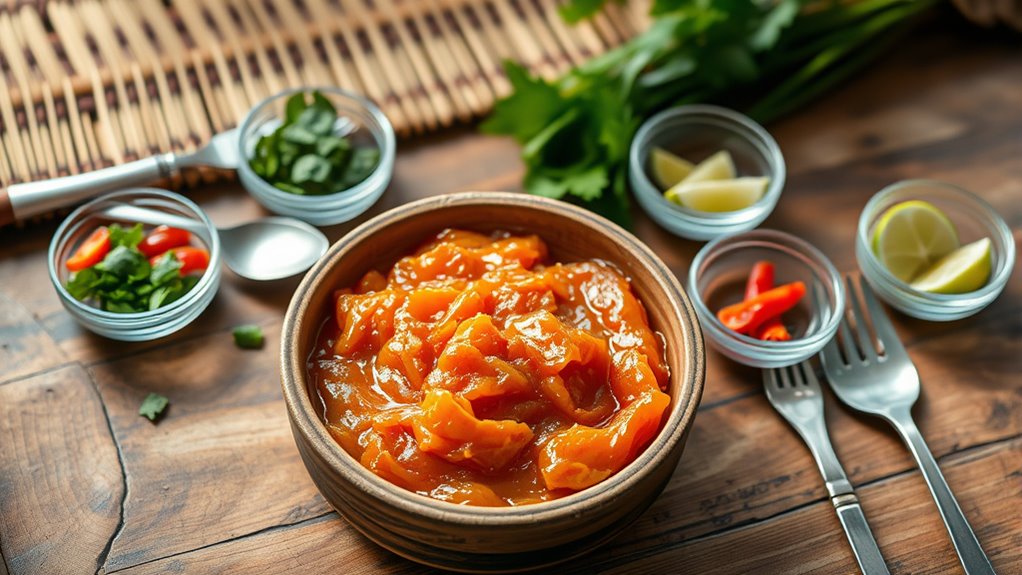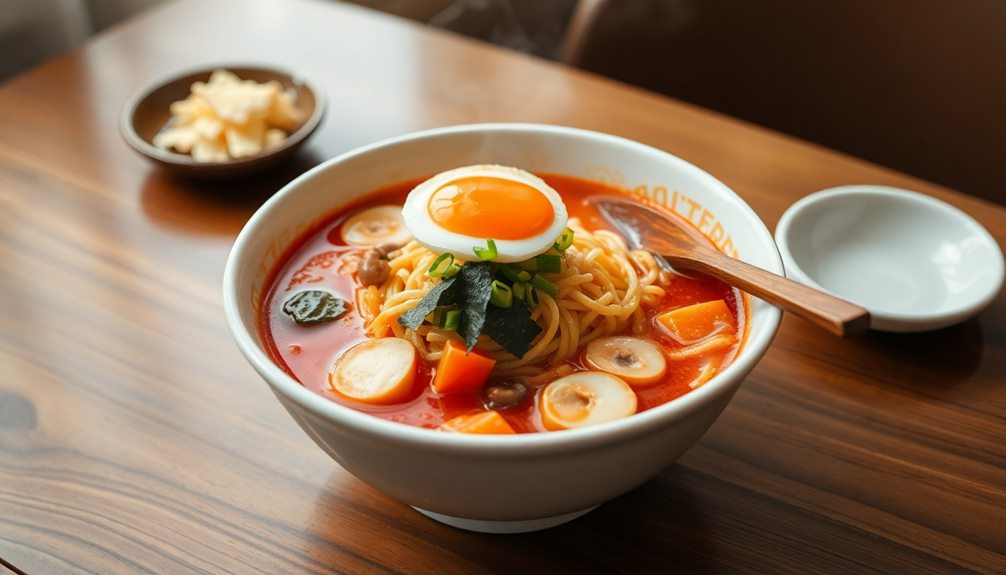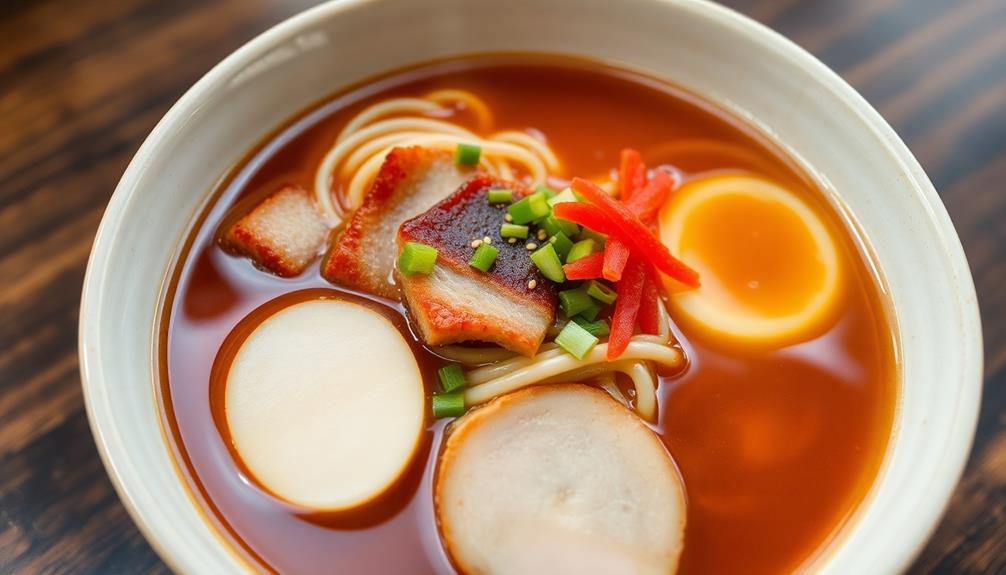To keep Cambodian prahok safe, store it in a clean, airtight container in the refrigerator if not used immediately and keep utensils clean to prevent contamination. Make certain proper fermentation by using fresh fish, maintaining correct salt levels, and keeping it in a cool, dark place. Regularly check for spoilage signs like off smells or slimy textures. For more detailed safety tips, continue exploring how to handle and monitor prahok properly.
Key Takeaways
- Keep prahok in airtight, hygienic containers and store in the refrigerator or freezer to prevent spoilage and contamination.
- Use clean utensils and wipe container rims after each use to maintain hygiene and prevent mold growth.
- Monitor fermentation regularly for off smells, sliminess, or discoloration; discard any spoiled batches immediately.
- Maintain proper salt levels and store in a cool, dark place to ensure safe fermentation and inhibit harmful microbes.
- Freeze prahok for long-term storage to halt fermentation and preserve safety and quality.

Are you aware of the best practices to handle prahok safely? When dealing with this traditional Cambodian fermented fish paste, proper prahok storage is vital to prevent contamination and guarantee its quality. The fermentation process is delicate, and mishandling can lead to spoilage or health risks. To keep your prahok safe, you need to understand how to store it correctly and what to watch out for during fermentation.
First, always keep prahok in a clean, airtight container. This prevents unwanted bacteria or molds from contaminating the paste. Ideally, store it in the refrigerator, especially if you’re not planning to use it immediately. Cold storage slows down the fermentation process and inhibits the growth of harmful microorganisms. If you buy prahok in bulk, divide it into smaller portions and store each separately, so you don’t have to keep opening the entire batch repeatedly. This reduces the risk of introducing bacteria from utensils or hands each time you handle it.
The fermentation process plays an essential role in the safety and flavor of prahok. During fermentation, naturally occurring bacteria convert fish and salt into a savory paste. However, if the process isn’t managed properly, it can produce harmful pathogens. To guarantee safety, make sure the fish used are fresh and clean before starting fermentation. Maintain the right salt concentration, as too little salt can lead to bacterial growth, while too much may hinder fermentation altogether. Keep the fermentation environment clean and covered to prevent dust or insects from contaminating the paste. The container should be stored in a cool, dark place during fermentation, ideally between 20-25°C (68-77°F), which allows the beneficial bacteria to develop without encouraging dangerous ones. Additionally, understanding the fermentation process helps in ensuring the safety and quality of prahok. Proper temperature control during fermentation is crucial to prevent the growth of undesirable microorganisms that could compromise safety. Monitoring the pH level can also be beneficial, as a stable pH indicates proper fermentation and safety. Incorporating regular checks of microbial activity can further support safe fermentation practices.
Regularly check your prahok during fermentation. Look for signs of spoilage such as an off smell, slimy texture, or unusual discoloration. If you notice any of these, discard the batch immediately. Proper prahok storage also involves maintaining hygiene; always use clean utensils when handling it to avoid introducing bacteria. When you’ve finished using some prahok, wipe the container’s rim to prevent mold growth or spoilage. If you plan to keep it for an extended period, consider freezing portions, which halts fermentation and preserves it for longer.
Frequently Asked Questions
How Long Can Prahok Be Stored Safely?
You wonder how long prahok can be stored safely. Typically, its storage duration depends on how well you keep it sealed and refrigerated. Check for spoilage indicators like an off smell, slimy texture, or mold. If stored properly in an airtight container in the fridge, prahok usually stays good for up to 6 months. Always trust your senses; discard it if you notice any signs of spoilage.
Can Prahok Be Frozen for Preservation?
Imagine locking in the essence of Prahok’s vibrant fermentation, preserving its soul like a treasure chest. Yes, you can freeze Prahok using proper freezing techniques to extend its storage duration. Wrap it tightly to prevent freezer burn, then store it in the cold for up to several months. Freezing helps maintain flavor and safety, but remember, over time, quality may diminish, so enjoy it while the taste remains fresh and lively.
Are There Any Health Risks From Homemade Prahok?
You might wonder if homemade prahok poses health risks. While fermentation can enhance flavor, homemade fermentation without proper hygiene or control can lead to contamination or spoilage. If not handled carefully, bacteria or toxins could develop, risking foodborne illnesses. To reduce health risks, guarantee you follow proper fermentation techniques, maintain cleanliness, and monitor the prahok closely during the process. When in doubt, consult safety guidelines to enjoy your homemade prahok safely.
How Can I Tell if Prahok Has Gone Bad?
Did you know that improper storage can cause prahok spoilage, leading to health risks? To tell if prahok has gone bad, check for an odor change—an unpleasant, sour, or ammonia-like smell signals spoilage. Also, look for mold presence, which indicates it’s no longer safe to eat. If either appears, discard it immediately to avoid potential food poisoning. Always store prahok in a cool, airtight container to prolong freshness.
Is Prahok Safe for Pregnant Women to Consume?
You wonder if prahok is safe for pregnancy, and it is worth mentioning that fish paste safety varies. During prahok pregnancy, you should be cautious because fermented fish can contain harmful bacteria or high levels of salt and histamines. To protect yourself and your baby, consult your healthcare provider about fish paste safety, and consider avoiding prahok if you’re unsure about its freshness or preparation process.
Conclusion
By following these prahok safety guidelines, you protect your health, preserve tradition, and enjoy authentic flavor. You guarantee freshness, avoid contamination, and respect craftsmanship. You savor each bite, trust each step, and embrace each process. Stay vigilant, stay informed, and stay safe—because your well-being depends on it. When you prioritize safety, you protect your palate, your community, and the rich heritage of Cambodian prahok. Together, let’s enjoy tradition responsibly and confidently.









